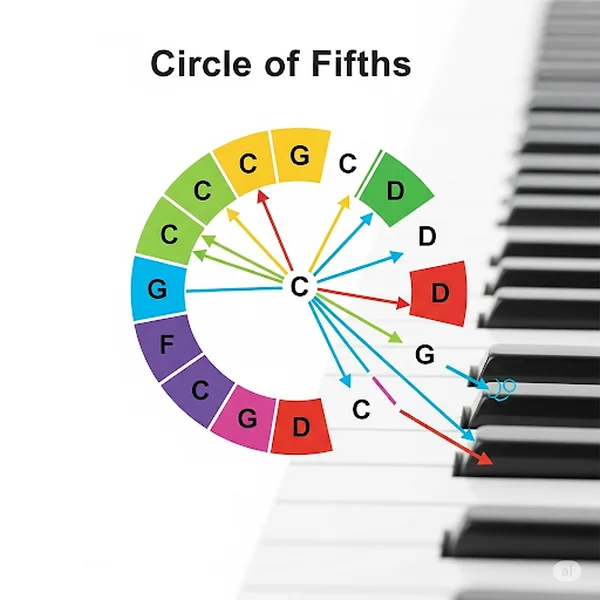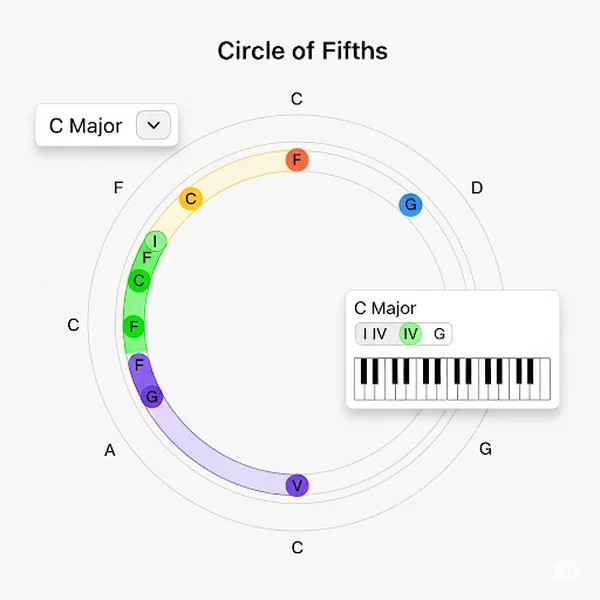Unlock Piano Skills: Circle of Fifths Guide
Are you a pianist looking to deepen your understanding of music theory and elevate your playing? Many musicians have heard of the circle of fifths, but how can the Circle of Fifths improve my piano playing specifically? This guide will unlock practical ways this powerful concept can transform your approach to the piano, from mastering scales and chords to boosting your improvisation skills. Dive in and discover how you can integrate circle of fifths piano techniques into your daily routine. For a fantastic visual aid, you can always explore our interactive tool.
What is the Circle of Fifths?
Before we dive into specific piano applications, let's quickly refresh our understanding of the circle of fifths. It's a visual representation of the relationships between the twelve chromatic pitches. Each note is a perfect fifth away from the next, moving clockwise. For pianists, this isn't just abstract theory; it’s a roadmap to understanding key signatures, chord relationships, and harmonic movement. How to understand key signatures on piano using Circle of Fifths? The Circle makes this incredibly intuitive.

Visualizing the Circle on the Piano Keyboard
Imagine C at the top. Move a perfect fifth up, and you land on G. Move another perfect fifth from G, and you get D. This pattern translates to the piano keyboard, helping you see how keys are related. The number of sharps or flats increases predictably, invaluable for piano key signatures.
Key Takeaways for Piano Practice from the Circle
Understanding the circle of fifths offers benefits for your piano practice theory:
- A logical way to practice scales and arpeggios.
- A clear visual for understanding piano chords scales.
- A foundation for confident piano improvisation circle of fifths techniques.
- An easier way to grasp transposing.
See these relationships in action? Try our tool for an interactive experience.
Mastering Scales & Arpeggios with the Circle of Fifths Piano Method
One immediate application of the circle of fifths piano method is tackling scales and arpeggios. What's the best way to practice piano scales with the Circle of Fifths? Moving around the Circle creates a structured routine.
Practicing All 12 Major Piano Scales Systematically
Use the circle of fifths as your guide. Start with C major. Move clockwise to G major, then D major, and so on. This progression makes learning piano key signatures feel natural. Each new scale introduces just one new sharp or flat, making it easier to improve piano playing by building a solid technical foundation.

Efficiently Learning Minor Piano Scales and Their Relationships
The circle of fifths is equally powerful for major minor scales piano. Each major key has a relative minor, found three semitones below it. Practicing these pairs together reinforces their connection. Our interactive circle clearly shows these relationships.
Piano Arpeggio Drills Following the Circle's Logic
Structure your arpeggio practice around the circle of fifths. Play major and minor arpeggios for each key as you move around. This builds dexterity and deepens your understanding of keyboard harmony. These piano exercises circle of fifths based drills are highly effective.
Understanding Piano Chords and Harmony via the Circle of Fifths
The circle of fifths is a goldmine for understanding piano chords and harmony. How does the Circle of Fifths help with piano chords? It visually lays out chord relationships.
Identifying Diatonic Chords in Any Key on Piano
For any given key on the circle of fifths, adjacent chords are closely related. In C major, G major (V) and F major (IV) are neighbors, revealing primary chords. To truly visualize music theory piano, visit our site now – our tool makes this clear!

Building Common Piano Chord Progressions with the Circle
Many common piano chord progressions follow patterns on the circle of fifths. The ii-V-I progression involves moving counter-clockwise. Understanding these patterns accelerates your ability to play and create progressions. This is key to learn piano with circle of fifths.
Exploring Piano Chord Inversions with the Circle's Guidance
While the circle of fifths doesn't directly show inversions, understanding its root movement informs voice leading. The Circle helps anticipate harmonic shifts, making your understanding piano chords more profound.
Using the Circle of Fifths for Piano Improvisation and Songwriting
Ready to get creative? Can I use the Circle of Fifths for piano improvisation? Absolutely! It’s a fantastic songwriting piano tool.
Finding Compatible Chords for Melodies on Piano
The circle of fifths helps identify harmonically related chords. If your melody is in C major, chords like G, Am, F, and Dm are excellent starting points. This makes the circle of fifths for keyboard players invaluable.
Modulating Between Keys Smoothly on Piano
Modulation adds excitement. The circle of fifths shows smooth pathways. Modulating to an adjacent key is often most natural. Practicing transposing piano music using these relationships builds harmonic fluency.
Tips for Keyboard Improvisation using Circle of Fifths Patterns
Try improvising through chord sequences dictated by the circle of fifths. For example, play a ii-V-I in C, then move to G for its ii-V-I, and so on. This piano improvisation circle of fifths exercise builds your ear.
Practical Piano Practice Theory: Exercises Using the Circle of Fifths
Let's make this concrete. What are some Circle of Fifths exercises for piano? Integrating these will solidify your skills.
Daily Piano Warm-ups Moving Around the Circle
Start your practice by picking a key on the circle of fifths, play its major scale and primary triads, then move to the next key. This reinforces piano key signatures and basic keyboard harmony.
Transposing Simple Piano Pieces with the Circle's Help
Take a simple melody. Using the circle of fifths, try transposing piano music to a new key. This practical application of piano practice theory is beneficial.
How Our Tool Enhances Your Piano Practice Visualization
Our interactive circle complements piano practice:
- Visualize Key Signatures: Select a key on our tool to see its signature.
- See Chord Relationships: Click a key to highlight its diatonic chords.
- Explore Modulations: Plan modulations visually. This tool to visualize music theory piano makes concepts tangible.
Elevate Your Piano Journey with the Circle of Fifths
The circle of fifths piano applications are vast. From solidifying understanding of scales, chords, and piano key signatures to unlocking new pathways for improvisation, it's essential. By integrating these techniques, and using resources like our interactive tool, you'll improve your skills.
Your Piano & Circle of Fifths Questions Answered
-
How can the Circle of Fifths improve my piano playing?
It provides a framework for understanding keys, mastering scales/chords, simplifying transposition, and guiding improvisation. For a hands-on experience, try our interactive features.
-
What's the best way to practice piano scales with the Circle of Fifths?
Move systematically around the Circle (e.g., C major, G major, D major). Do the same for minor scales. This makes learning all 12 keys manageable. You can visualize this progression here as you practice.
-
How does the Circle of Fifths help with piano chords?
It visually shows how chords relate within a key, helping understand progressions and keyboard harmony.
-
Can I use the Circle of Fifths for piano improvisation?
Yes! It helps choose related chords, plan modulations, and generate melodic ideas.
-
Is your online Circle of Fifths good for pianists?
Yes, our interactive tool is a powerful aid. You can see key signatures, chord relationships, and visualize connections, making abstract theory concrete.